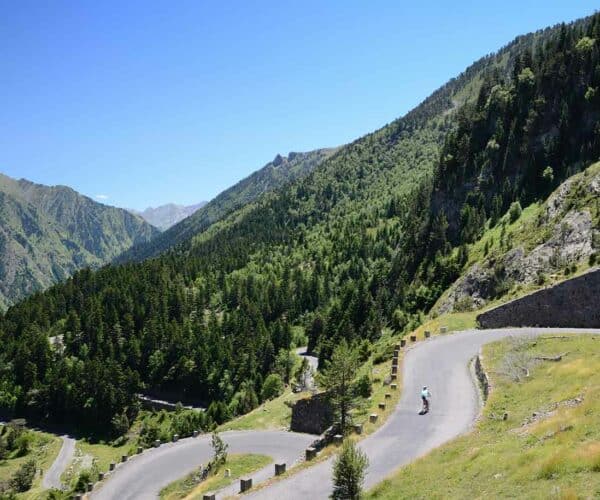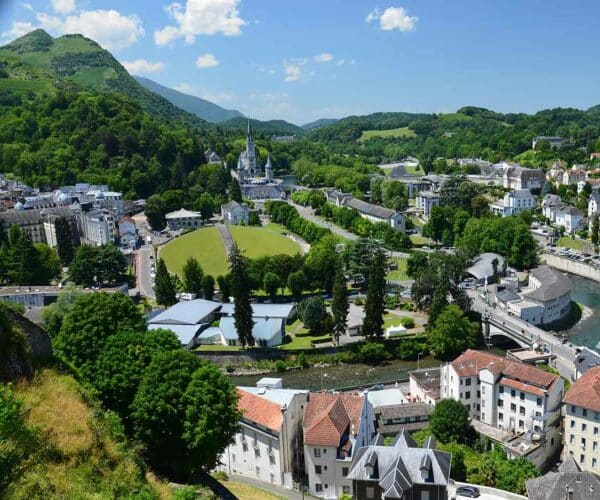Cycling in the Pyrenees offers an incredible experience for cyclists of all levels, with stunning mountain scenery, challenging climbs, and thrilling descents.
The Pyrenees Mountain range forms a natural border between France and Spain, stretching approximately 430 kilometres (267 miles) from the Atlantic Ocean to the Mediterranean Sea. The region is known for its challenging climbs, with many famous mountain passes featured in cycling’s most prestigious races, such as the annual Tour de France.
In our overview of this famous cycling terrain, we’ll look at some of the most popular routes and climbs you can find in the Pyrenees. We’ll also cover useful information like the best time to visit, how fit you need to be to cycle here and where to stay in the Pyrenees, so you can make the most of your cycling trip.
Popular Cycling Routes and Climbs

Col du Tourmalet
One of the most famous and iconic climbs in the Pyrenees, Col du Tourmalet is frequently featured in the Tour de France. The climb starts from Sainte-Marie-de-Campan or Luz-Saint-Sauveur and ascends to an altitude of 2,115 meters.
Col d'Aubisque
Another legendary climb in the Pyrenees, Col d’Aubisque offers stunning views and challenging gradients. The climb starts from Laruns and reaches an altitude of 1,709 meters.
Col du Soulor
Often combined with Col d’Aubisque, Col du Soulor is a beautiful climb with less traffic and breathtaking scenery. The climb starts from Argelès-Gazost and reaches an altitude of 1,474 metres.
Col du Portet
A newer addition to the Tour de France route, Col du Portet is a challenging climb with steep gradients and stunning views. The climb starts from Saint-Lary-Soulan and ascends to an altitude of 2,215 meters.
Highest climbs of the Pyrenees

The Pyrenees offer some of the most challenging and scenic cycling climbs in Europe. Here are the highest and most iconic ones:
Col du Tourmalet
Height: Stands at 2,115 meters above sea level.
Popular and high, it has to go in both lists! The Col du Tourmalet is the highest road pass in the Hautes-Pyrénées and has been featured in the Tour de France a whopping 82 times! The ascent is demanding, but the views are rewarding.
Port d’Envalira (Andorra/France)
Height: Reaches 2,407 meters.
This pass connects Andorra and France. The ascent offers stunning mountain scenery and challenging gradients. A must-ride for serious cyclists.
Col de Mente
Height: Ascends to 2,215 meters.
A classic Pyrenean climb, Col de Mente gained international attention in 1971 when Luis Ocaña, leading the Tour de France, crashed on its slopes. The descent is equally thrilling.
Plateau de Beille
Height: Reaches 1,790 meters.
Known for its challenging gradient (average of around 8% for 16 kilometres), Plateau de Beille has been a favourite stage finish in recent Tour de France editions. The final 3 kilometres offer beautiful views across the valley.
Col d’Aspin
Height: Stands at 1,489 meters.
Regularly used in the Tour de France, the Col d’Aspin is a classic Pyrenean climb. The ascent from Arreau provides open views and hairpin bends for an enjoyable ride.
Cycling Events in the Pyrenees

The Pyrenees host several cycling events and races throughout the year, including sportive, gran fondos, and amateur races. These events offer cyclists the opportunity to challenge themselves on famous climbs and routes in the region.
The Pyrenees offer an array of exciting cycling events and experiences. Whether you’re a seasoned cyclist or a passionate enthusiast, these events allow you to explore the stunning landscapes and challenging climbs.
Tour de France
The world’s most prestigious cycling race, the Tour de France, often includes stages in the Pyrenees. Witness professional cyclists tackle iconic climbs like the Col du Tourmalet and Plateau de Beille. The atmosphere during the Tour is electric, and you can join the crowds cheering on the riders.
Dates: June-July 2024
L’Étape du Tour
L’Étape du Tour is a mass participation event that allows amateur cyclists to ride a stage of the Tour de France. Each year, one of the Tour stages is selected for this challenging sportive. In the Pyrenees, you’ll experience the same roads as the pros.
Dates: July 2024
Haute Route Pyrenees
The Haute Route Pyrenees is a multi-day cycling event that covers some of the most demanding climbs in the region. It’s designed for serious cyclists who want to test their limits. Expect challenging ascents, stunning descents, and camaraderie among participants.
Dates: July 2024
Weather in the Pyrenees
The cycling season in the Pyrenees typically runs from late spring to early autumn, with the best weather conditions occurring from June to September. However, weather in the mountains can be unpredictable, so it’s important to be prepared for sudden changes in temperature, wind, and precipitation.
How fit do you need to be to cycle in the Pyrenees?

Cycling in the Pyrenees can be physically demanding due to the challenging terrain, steep climbs, and high altitudes. The level of fitness required will depend on the specific routes and climbs you plan to tackle, as well as your individual cycling experience and abilities. Let’s look at some factors to consider when assessing your fitness level for cycling in the Pyrenees:
Gradient and Elevation Gain
Many of the famous climbs in the Pyrenees, such as Col du Tourmalet, Col d’Aubisque, and Col du Portet, feature steep gradients and significant elevation gain. You’ll need to be prepared for sustained efforts and long climbs with gradients reaching 10% or more.
Altitude
Cycling at high altitudes can be more challenging due to reduced oxygen levels and increased cardiovascular strain. Some mountain passes in the Pyrenees reach altitudes of over 2,000 metres, so it’s important to acclimate to the altitude and pace yourself accordingly.
Endurance
Cycling in the Pyrenees often involves long distances and several hours of continuous riding. You’ll need to have good cardiovascular endurance and stamina to tackle multiple climbs and descents in a single day.
Experience
Previous cycling experience, including riding on hills and mountains, will be beneficial for cycling in the Pyrenees. Familiarity with climbing techniques, pacing strategies, and handling descents safely will enhance your confidence and enjoyment of the ride.
Training
It’s advisable to undertake specific training to prepare for cycling in the Pyrenees. This may include building aerobic fitness through long rides and interval training, improving strength and power through hill repeats and weight training, and practicing bike handling skills.
Nutrition and Hydration
Proper nutrition and hydration are essential for sustained performance during long rides in the Pyrenees. Ensure that you’re adequately fuelling your body with carbohydrates, proteins, and fluids before, during, and after your rides to maintain energy levels and prevent dehydration.
Rest and Recovery
Allow sufficient time for rest and recovery between rides to prevent overtraining and reduce the risk of injury. Listen to your body and adjust your training and riding schedule as needed to avoid burnout and fatigue.
Overall, while cycling in the Pyrenees can be challenging, cyclists of varying fitness levels can enjoy the experience by choosing routes and climbs that align with their abilities and goals. It’s essential to be realistic about your fitness level, set achievable objectives, and gradually build up your strength, endurance, and confidence over time. Additionally, don’t hesitate to seek advice from experienced cyclists or coaches for training tips and guidance tailored to your individual needs.
Where to stay for cycling in the Pyrenees?

Argelès-Gazost
Argelès-Gazost is superbly positioned for accessing some of the most iconic road climbs in the Pyrenees.
Notable Climbs
Col d’Aubisque: Signposted from the town centre.
Hautacam: Starts just outside the town.
Col du Tourmalet (western side): Approximately 18 kilometres away.
Lourdes
Lourdes is a pilgrimage site and offers a unique cultural experience alongside cycling adventures. It provides access to renowned Tour de France climbs, including the Col du Tourmalet.
Notable Climbs
Col du Tourmalet (eastern side): Via Luz-Saint-Sauveur.
Bagneres de Bigorre
Bagneres de Bigorre is a charming base with plenty of cycling opportunities. This town is strategically located for tackling challenging climbs.
Notable Climbs
Col d’Aspin and Hourquette d’Ancizan (from the west).
Travelling to the Pyrenees

There are several options to choose from to reach the Pyrenees, depending on your budget. Whether you’re travelling with a bike and other equipment may be influential to your decision. These are your options:
By Car
If you prefer flexibility and want to explore at your own pace, consider driving to the Pyrenees. The Pyrenees stretch for 430 kilometres along the Franco-Spanish border, offering breathtaking views and pristine wilderness. Major highways like E15 and E9 connect various regions within the Pyrenees. Remember to check road conditions, especially if you plan to drive during winter.
By Train
For a slower but spectacular travel option take a scenic train ride. The Train d’Artouste is Europe’s highest train, winding through the Pyrenees. Take in the stunning views from the comfort of your seat!
High-Speed Option
If you’re coming from major cities, consider taking a high-speed train to nearby cities like Barcelona or Toulouse, and then continue your journey by other means.
By Plane
The Pyrenees region is served by several airports. The closest international airports include Toulouse-Blagnac Airport (France) and Barcelona-El Prat Airport (Spain).
From these airports, you can take connecting flights to smaller regional airports like Pau Pyrénées Airport or Tarbes-Lourdes-Pyrénées Airport.
Get Cycling Travel Insurance with SportsCover Direct
SportsCover Direct’s cycling insurance has been designed to give protection for worldwide cycling travel, whatever cycling challenge you’re pursuing make sure you have the right insurance to cover you for injuries and other travelling incidents.
Our cycling travel insurance covers you abroad, whether you’re enjoying the sport for leisure or cycling competitively. It offers cover for medical costs, equipment, cancelled trips and more. If you already have travel insurance, our bolt-on allows you to add the protection you need for cycling. You can also opt for our sports accident insurance, which has been created to protect you while cycling in the UK.
Find out more and get an instant quote designed to suit you.
This blog has been created as general information and should not be taken as advice. Make sure you have the correct level of insurance for your requirements and always review policy documentation.